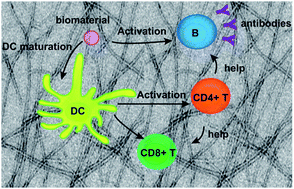Engaging adaptive immunity with biomaterials
Abstract
Adaptive immune responses, characterized by T cells and B cells engaging and responding to specific antigens, can be raised by biomaterials containing proteins, peptides, and other biomolecules. How does one avoid, control, or exploit such responses? This review will discuss major properties and processes that influence biomaterials-directed adaptive immunity, including the physical dimensions of a material, its epitope content, and its multivalency. Selected strategies involving novel biomaterials designs will be discussed to illustrate these points of control. Specific immunological processes that biomaterials are being developed to direct will be highlighted, including minimally inflammatory scaffolds for tissue repair and immunotherapies eliciting desired B cell (antibody) responses, T cell responses, or tolerance. The continuing development of a knowledge base for specifying the strength and phenotype of biomaterials-mediated adaptive immune responses is important, not only for the engineering of better vaccines and immunotherapies, but also for managing immune responses against newer generations of increasingly biological and biomolecular materials in contexts such as tissue repair, tissue engineering, or cell delivery.

- This article is part of the themed collections: Emerging Investigators and 2014 Journal of Materials Chemistry B Hot Articles

 Please wait while we load your content...
Please wait while we load your content...